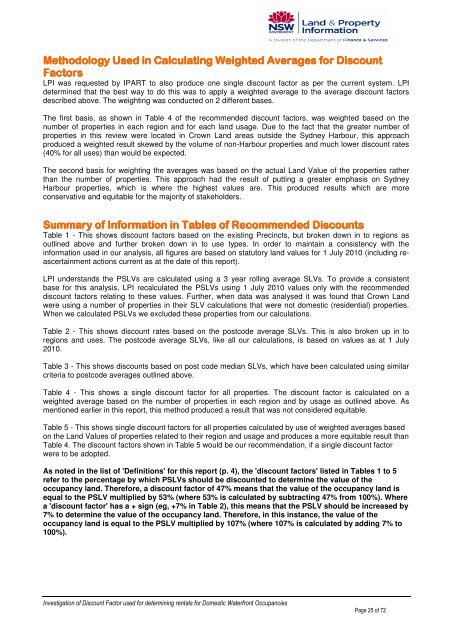Consultant Report - IPART
Consultant Report - IPART
Consultant Report - IPART
You also want an ePaper? Increase the reach of your titles
YUMPU automatically turns print PDFs into web optimized ePapers that Google loves.
Methodology Used in Calculating Weighted Averages for Discount<br />
Factors<br />
LPI was requested by <strong>IPART</strong> to also produce one single discount factor as per the current system. LPI<br />
determined that the best way to do this was to apply a weighted average to the average discount factors<br />
described above. The weighting was conducted on 2 different bases.<br />
The first basis, as shown in Table 4 of the recommended discount factors, was weighted based on the<br />
number of properties in each region and for each land usage. Due to the fact that the greater number of<br />
properties in this review were located in Crown Land areas outside the Sydney Harbour, this approach<br />
produced a weighted result skewed by the volume of non-Harbour properties and much lower discount rates<br />
(40% for all uses) than would be expected.<br />
The second basis for weighting the averages was based on the actual Land Value of the properties rather<br />
than the number of properties. This approach had the result of putting a greater emphasis on Sydney<br />
Harbour properties, which is where the highest values are. This produced results which are more<br />
conservative and equitable for the majority of stakeholders.<br />
Summary of Information in Tables of Recommended Discounts<br />
Table 1 - This shows discount factors based on the existing Precincts, but broken down in to regions as<br />
outlined above and further broken down in to use types. In order to maintain a consistency with the<br />
information used in our analysis, all figures are based on statutory land values for 1 July 2010 (including reascertainment<br />
actions current as at the date of this report).<br />
LPI understands the PSLVs are calculated using a 3 year rolling average SLVs. To provide a consistent<br />
base for this analysis, LPI recalculated the PSLVs using 1 July 2010 values only with the recommended<br />
discount factors relating to these values. Further, when data was analysed it was found that Crown Land<br />
were using a number of properties in their SLV calculations that were not domestic (residential) properties.<br />
When we calculated PSLVs we excluded these properties from our calculations.<br />
Table 2 - This shows discount rates based on the postcode average SLVs. This is also broken up in to<br />
regions and uses. The postcode average SLVs, like all our calculations, is based on values as at 1 July<br />
2010.<br />
Table 3 - This shows discounts based on post code median SLVs, which have been calculated using similar<br />
criteria to postcode averages outlined above.<br />
Table 4 - This shows a single discount factor for all properties. The discount factor is calculated on a<br />
weighted average based on the number of properties in each region and by usage as outlined above. As<br />
mentioned earlier in this report, this method produced a result that was not considered equitable.<br />
Table 5 - This shows single discount factors for all properties calculated by use of weighted averages based<br />
on the Land Values of properties related to their region and usage and produces a more equitable result than<br />
Table 4. The discount factors shown in Table 5 would be our recommendation, if a single discount factor<br />
were to be adopted.<br />
As noted in the list of 'Definitions' for this report (p. 4), the 'discount factors' listed in Tables 1 to 5<br />
refer to the percentage by which PSLVs should be discounted to determine the value of the<br />
occupancy land. Therefore, a discount factor of 47% means that the value of the occupancy land is<br />
equal to the PSLV multiplied by 53% (where 53% is calculated by subtracting 47% from 100%). Where<br />
a 'discount factor' has a + sign (eg, +7% in Table 2), this means that the PSLV should be increased by<br />
7% to determine the value of the occupancy land. Therefore, in this instance, the value of the<br />
occupancy land is equal to the PSLV multiplied by 107% (where 107% is calculated by adding 7% to<br />
100%).<br />
Investigation of Discount Factor used for determining rentals for Domestic Waterfront Occupancies<br />
Page 25 of 72
















